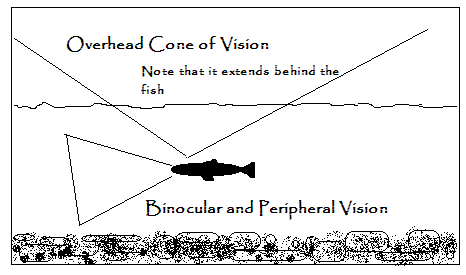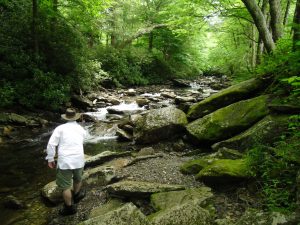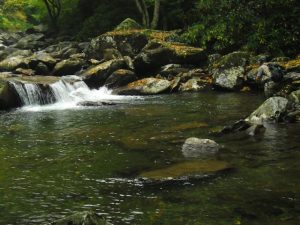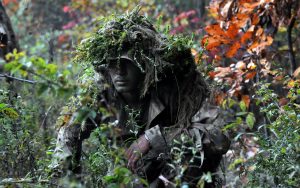In normal years, there are going to be periods that are dryer than others, and in a rainfall driven fishery like the Smoky Mountains, water levels routinely fluctuate and you have to be able to adjust your strategies to match the conditions. While some years can give us low water conditions any time of year, late summer and fall is historically the driest time of year in the Smokies.
What’s particularly bad is when we have a summer drought with low water AND warm water temperatures. That’s a pretty tough combination – one that often results in the loss of fish. But when you’re dealing with the typical low water we see in September and particularly October, water temperatures are cool and trout are very active. So, there’s one obstacle, warm water temperatures, out of the way. Below are some tips for dealing with the other obstacle.
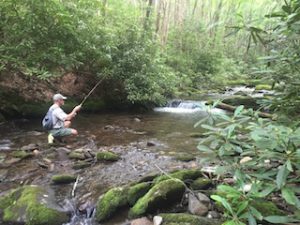
The biggest problem low water creates is it makes already spooky fish spookier. While having less water depth can be an issue, the real challenge is having less water flow. When streams are full, the extra flow of water helps conceal you and your movements. The surface is more broken, making the trout’s view of the outside world more distorted and the extra flow helps to dampen the noise you make when you move in or near the water. In a nutshell, you’re going to have to be a lot stealthier when you fish for low water trout.
I’ve talked about this first piece in the article Dress for Success, but it all starts with what you wear. When you are fishing in the Smoky Mountains, your backdrop consists mostly of trees and bushes. When you wear bright colors, your silhouette against that woody backdrop is much more pronounced, and the trout more easily detects your movements. Dress in dull, earth-tone colors like brown, tan, olive, or grey. And stay low. Crouching, squatting, kneeling and/or staying behind boulders will help eliminate your silhouette altogether.
Without the benefit of faster currents, you have to stay farther away from the fish. Simply staying back farther and casting farther can cause drag issues when you’re working across currents, as more line will be on the water. Use the longest rod you can get away with to allow for extra reach across those currents. With shorter rods, take extra measures to position yourself as much downstream from the fish as possible. This will put your line/leader more in the same speed current as the fly and provide a better drift.
Speaking of lines… Heavier fly lines will make more commotion on the water and will drag more. Try using lighter lines, 4-weight and smaller, and keep them off the water as much as you can by keeping the rod tip up. Longer leaders with longer and finer tippet will also help with less drag and less commotion on the water. For small to mid size streams, I usually fish 9’ leaders in low water, and often 12’ leaders on larger rivers.
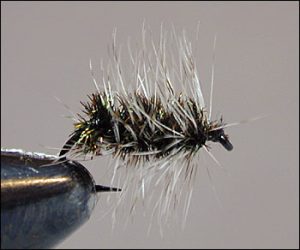
Lower, slower moving water also gives the fish a better, longer look at your fly. Larger, bushier flies will often produce “short strikes,” where the fish merely bumps or noses it, or stops just short of taking it. Smaller flies and low profile flies like parachutes or comparaduns, will often solve that. A Griffith’s Gnat in a size #18 is a favorite late season, low water pattern. A Parachute Adams in size #18 is another favorite. Terrestrials are still abundant this time of year and a small parachute ant or a soft hackle ant dropper can be very effective in these conditions.
You may also try to seek out choppier water. Fish will often position themselves more in choppy water during these conditions to remain less visible to predators.
Mostly, success in low water is going to boil down to movement. Keep your false casting to an absolute minimum, like, not at all if you can. Don’t go rushing into each new spot. First, assess the pocket, pool, or run from afar, then keep a low profile and approach it slowly.
After doing all of this, as simple as it sounds, be ready! Your strike is most often going to come on the first cast and you don’t get many second chances.


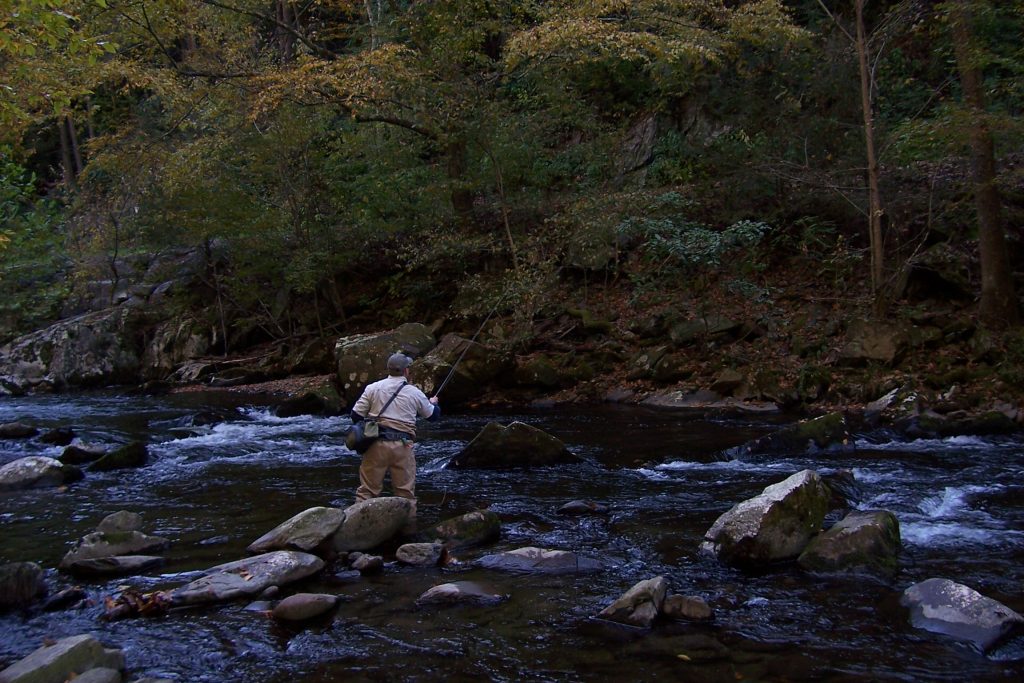 Check out the photo above – a typical stretch of water in the Smokies. You can easily see the numerous changes in current speed and direction in just this small area. Rather than standing at the bottom right of the photo and casting 40-50 feet to the top left of the photo, our angler is intelligently breaking this stretch into defined sections. He has likely already fished the water below, to his left, and right in front of him. Notice his rod is high, keeping the line off the current directly in front of him. The fly should drift nicely in the current breaking around the right of the boulder. Next, he will likely step up to the boulder and fish that large pocket above it. Well done!
Check out the photo above – a typical stretch of water in the Smokies. You can easily see the numerous changes in current speed and direction in just this small area. Rather than standing at the bottom right of the photo and casting 40-50 feet to the top left of the photo, our angler is intelligently breaking this stretch into defined sections. He has likely already fished the water below, to his left, and right in front of him. Notice his rod is high, keeping the line off the current directly in front of him. The fly should drift nicely in the current breaking around the right of the boulder. Next, he will likely step up to the boulder and fish that large pocket above it. Well done!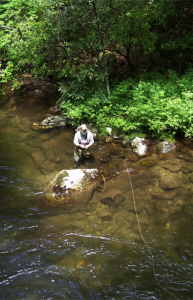 The angler in this photo is also doing a good job with a little more line out. Notice he is concealing himself behind a boulder. He’s holding his rod upward, keeping the current lip in front of him from grabbing the line. The line that is on the water is all in the same current speed. Again, well done!
The angler in this photo is also doing a good job with a little more line out. Notice he is concealing himself behind a boulder. He’s holding his rod upward, keeping the current lip in front of him from grabbing the line. The line that is on the water is all in the same current speed. Again, well done!